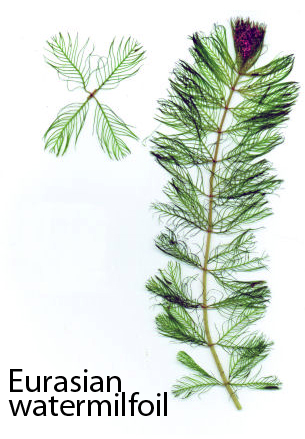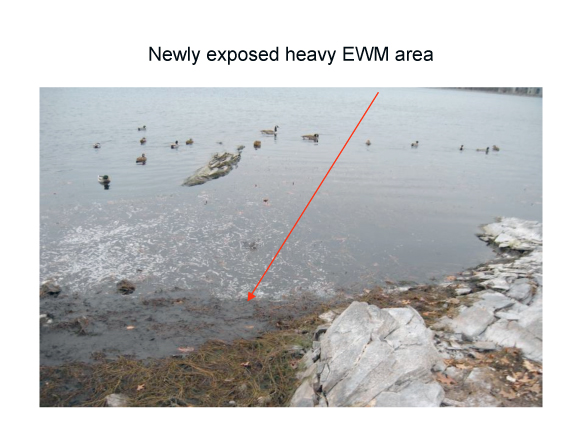Update: 02/27/15 - The refilling of the reservoir will begin within the week. The valves will be opened and water running down the embankment will be visible. It will take approximately 2 to 3 weeks to restore the reservoir to the normal operating elevation.
As a reminder, the elevation was dropped to expose part of the shoreline to the extreme winter temperatures that will kill the invasive plants that have been clogging the reservoir. We believe, that because of the very cold temperatures this winter, the mission has been accomplished.
-
Update: 01/05/15 - The reservoir lowering work has been completed for the winter.
-
For the last few years, MWRA has been battling Eurasian watermilfoil (Myriophyllum spicatum L.), an invasive plant found growing in the Chestnut Hill Reservoir. Last winter the reservoir was lowered by 10 feet in order to expose the shoreline to freezing conditions to kill off the Milfoil, as well as Fanwort. With the extreme cold and long duration of ice cover last season, the effort was successful in knocking back these plants. In fact, this year's aquatic plant harvest yielded just 79 cubic yards of plant matter compared to 607 cubic yards last year.
However, this success did come at a cost: the lack of invasive plants plus excessive nutrients, mainly phosphorous, from the reservoir sediment as well as from runoff (like geese feces) provided ideal conditions for a blue green algae bloom. As this algae expanded, it further shaded out light and prevented rooted plants from growing and absorbing nutrients. It's a bit of a tradeoff of problems. One of the concerns with blue green algae is that it can release toxins which are harmful to water quality. Remember, this is still an emergency drinking water distribution reservoir and MWRA must keep it ready for use, as was done in May 2010.
This year, MWRA is planning some adjustments to the reservoir management plan for 2014-2015 season. This week, drawdown of the reservoir will begin again for control of the dense shoreline invasive plants, but only five feet down. The target elevation should be reached in late December and will be kept at that level until the spring when the ice is gone.
Then, to deal with the high phosphorous levels that caused the blue green algae bloom, a low-dose alum treatment will be applied in the spring. Alum is aluminum sulfate, which is a non-toxic material commonly used in drinking water treatment plants to improve clarity. It is not harmful to aquatic life or people. Alum binds with the phosphorous to form aluminum hydroxide precipitate (or floc). As the floc settles to the bottom, it will remove the phosphorous from the water and lock it up in the sediment. An added benefit is that it will also collect other suspended particles in the water and improve water clarity. Once on the bottom, it will also act as a barrier to prevent phosphorous already in the sediment from cycling back into the water column.
MWRA will follow this treatment with periodic water quality monitoring to gauge its effectiveness, and will continue the annual survey to assess need for seasonal plant harvesting.
ABOUT THE CHESTNUT HILL RESEVOIR
The Chestnut Hill Reservoir, bordered by the cities of Boston and Newton, was built in 1870. It holds 500 million gallons of water and is an integral part of the MWRA’s emergency back-up water supply system. |
|



